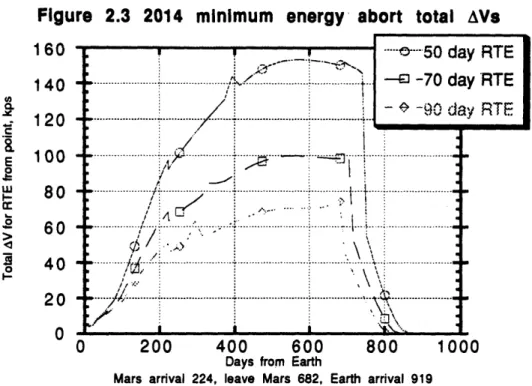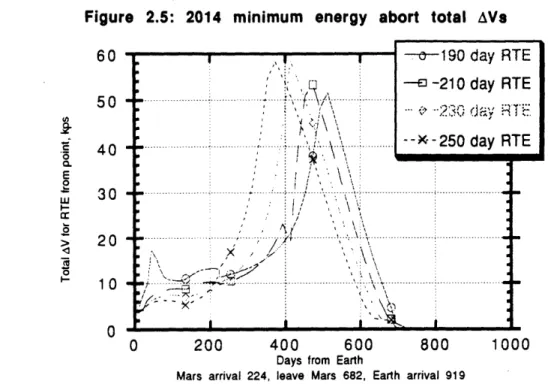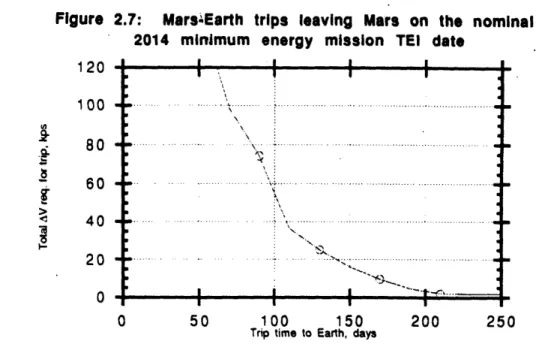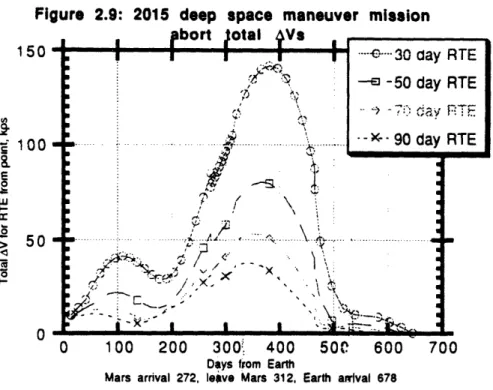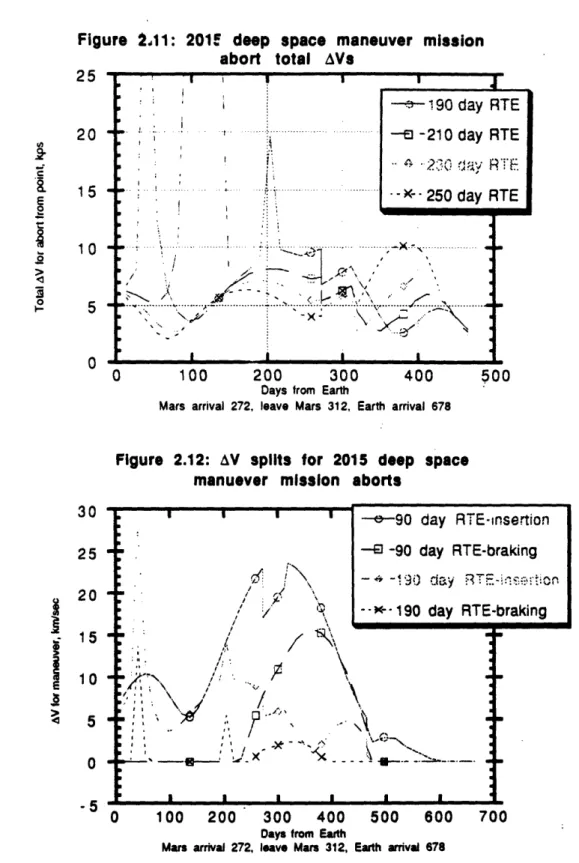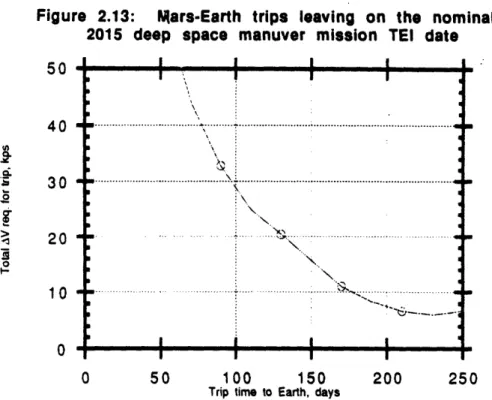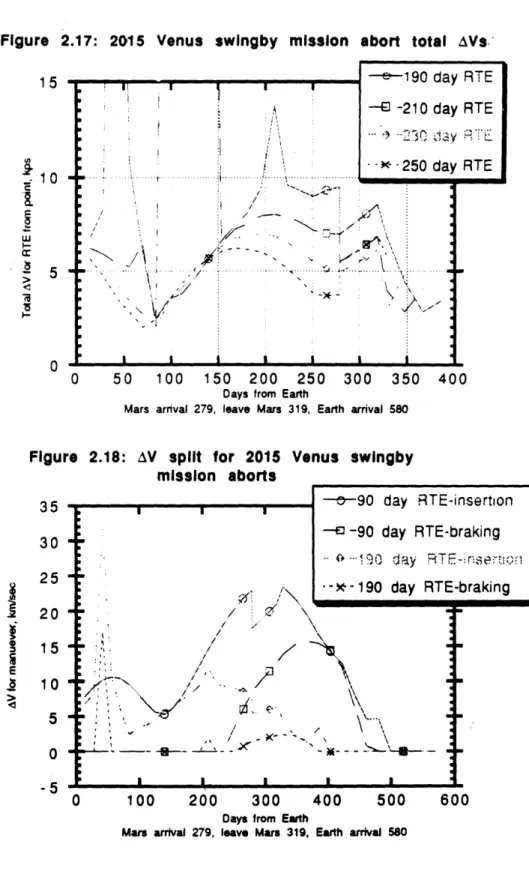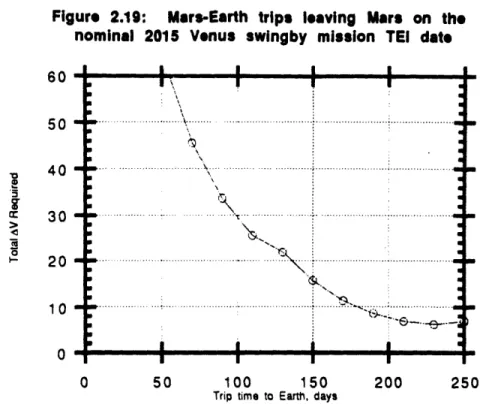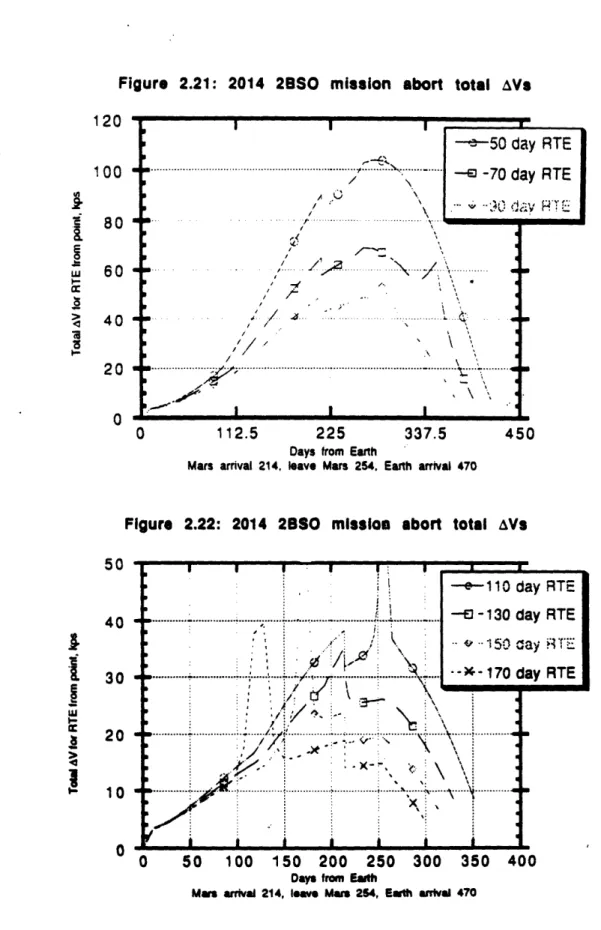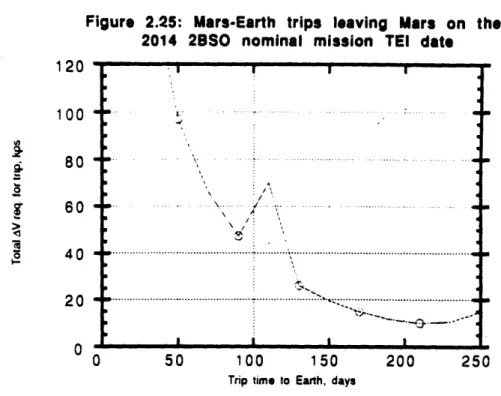ABORT SCENARIO FEASIBILITY FOR THE MANNED MARS MISSION
by
KEVIN PATRICK MAGUIRE
B.S., Aeronautics and Astronautics, Massachusetts Institute of Technology (1989)
B.S., Mathematics, Massachusetts Institute of Technology (1990)
SUBMITTED TO THE DEPARTMENT OF AERONAUTICS AND ASTRONAUTICS
IN PARTIAL FULFILLMENT OF THE REQUIREMENTS FOR THE
DEGREE OF MASTER OF SCIENCE
at the
MASSACHUSETTS INSTITUTE OF TECHNOLOGY September 1991
© Massachusetts Institute of Technology 1991 All rights reserved
Signature of Akuthor
Department &PAeronautics and Astronautics, August, 1991
Certified by
Cu
Joseph F. Shea Adjunct Professor, Aeronautics and Astronautics Thesis Supervisor Accepted by
I
Harold Y. Wachmin Chairman, Department Graduate Committee Department of Aeronautics and AstronauticsSEP
2 4 1991
~r n :i R 2 ---n lira J I 1 .1 1 MABORT SCENARIO FEASIBILITY FOR THE MANNED MARS MISSION
by
Kevin Patrick Maguire
Submitted to the department of Aeronautics and Astronautics on August 21, 1991 in partial fulfillment of the requirements for the Degree of
Master of Science in Aeronautics and Astronautics ABSTRACT
The Synthesis Group has released its recommendations for the mission architectures to be used for the manned Mars mission.
This study investigates the abort capabilities of the mission types
considered for the manned Mars mission and develops the costs in initial mass to low Earth orbit (IMLEO) of acquiring additional abort capability above that
available for the nominal missions.
It was found that specifying that a rapid return to Earth capability be available throughout the entire mission results in the initial mass to low Earth orbit being vastly increased, but that aborts with 160-200 day trip times are
available while outbound and at Mars using only the fuel carried by the nominal missions.
Reduction of the abort trip times from those available to the nominal mission was found to result in rapid increase in IMLEO well before the reduction in trip time became significant, so carrying contingency fuel to increase the abort capability available at mission points is not recommended.
The Synthesis Group specifies a split mission: an unmanned precursor mission carries the Mars exploration payloads and the return to Earth fuel to Mars on a minimum energy trajectory, and is followed by the piloted
spacecraft on a high-energy rapid transfer trajectory. This architecture is found to be inferior to one in which all the fuel required for the entire mission is carried on the piloted mission - the total IMLEO increases only slightly, and the abort capability of the nominal mission is greatly increased.
The effect of dividing the Mars transfer vehicle into two transfer vehicles, only one of which need be carried on an abort trajectory, is
investigated, and it is found that although splitting the transfer vehicle does not make carrying contingency fuel productive, it does provide substantial improvement in nominal mission abort capability for no change in IMLEO.
The 2015 Venus swingby mission, the non-minimum energy 2014/2015 mission with the lowest IMLEO, was found to offer better or comparable abort capability when compared to the other mission types considered for the first Mars launch, and is recommended as the mission to be used.
The abort capabilities of minimum-energy piloted missions were considered, and it was found that unless the mass of the transfer vehicle used for aborts is substantially less than the mass of the nominal transfer vehicle, requiring that aborts from Mars be. available if rendezvous with the cargo mission fails will increase IMLEO to the same level as the IMLEO of the nominal high-energy missions, without also improving abort capability and nominal mission performance.
Thesis Supervisor: Dr. Joseph F. Shea
TABLE OF CONTENTS
TITLE PA G E ... ... ... ... 1
A BSTR ACT ... ... ... 2
TABLE OF CONTENTS ... 3
LIST OF FIG URES ... ... 5
LIST O F TABLES ... ... 6
1.0.IN TR O D U CTIO N ... ... 7..
1..1 The Synthesis Group ... ... 7
1.2 M ission philosophy ... ... 7
1.3 Mission architecture... ... ... 8
1.4 Specified abort capability ... 10
1.5 Philosophy of abort capability ... ... ... 11
1.5.1 Failure scenarios which allow abort...13
2.0 ABORT TRAJECTORIES ... 15
2.1 Minimum energy missions ... 16
2.2 High-energy missions ... 16
2.3 Abort trajectory generation... 21
2.3.1. Earth arrival braking burn ... 21
2.3.2 MULIMP... ... 23
2.4 Selected mission abort trajectories ... .... 24
2.4.1 2014 minimum energy mission aborts ... 26
2.4.2. 2015 deep space maneuver mission aborts ... 29
2.4.3 2015 Venus swingby mission aborts ... 32
2.4.4 2014 2-burn short leg outbound (2BSO) mission ab o rts ... 3 5 2.4.5 2015 2-burn long leg outbound (2BLO) mission aborts...38
2.5 A bort types... 4 1 2.5.1 Outbound aborts ... 41
2.5.2 Abort from Mars orbit ... 42
2.5.3 Inbound aborts...44
2.5.4 Free return missions... ... 44
2.6 Comparison of missions for aborts... ... 47
3.0 IMPACT OF ABORT CAPABILITY ON IMLEO...48
3.1. A rchitectures ... ... 48
3.1.1. Baseline architecture split fuel m ission ... 48
3.1.2 Alternate architecture all fuel piloted mission ... 49
3.2. Mission configurations ... 50
3.3. Mass studies... 53
3.3.1. Mass study parameters ... 54
3.3.1.1 Fixed parameters... ... 54
3.3.1.2 Variable parameters ... 55
3.3.1.3 Output parameters ... 56
3.3.1.4 Abort parameters... 57
3.3.2 Behavior of total delta-V versus delta-V splits...58
3.3.3 Mass study methods ... 59
3.3.4 Split fuel mission mass study...60
3.3.5 All fuel piloted mass study method...62
3.4. Mass study results...64
4.0 A N A LY SIS ... 82
4.2 Analysis of abort capability vs mission IMLEOs ... 85
4.2.1 Outbound aborts ... ... 96
4.2.2 Aborts from Mars orbit... ... 99
4.2.3 Inbound aborts... ...101
4.3 Architecture analysis...104
4.4 Configuration analysis...106
4.5 Choice of optimal trajectory for 2014/2015 manned Mars m ission...107
4.6 Abort capability of minimum energy missions ... 109
5.0 RECOM M ENDATIONS ... 1 1 5.1 Fast vs slow aborts ... 11
5.2 Split transfer vehicle configuration... ... 111
5.3.Carrying return fuel on piloted or cargo mission...112
5.4.Inbound abort capability ... 113
5.5 Nominal missions vs. additional abort capability...114
5.6 Optimal mission for 2014/2015 manned Mars mission...115
5.7 Minimum energy mission profiles...115
5.8 Comparison to Synthesis Group baseline...116
B IB LIO G R A PH Y ... ... 117
APPENDIX A Abort trajectory data... ... 118
A.1 2014 minimum energy mission abort trajectories...119
A.2 2015 deep space maneuver mission abort trajectories ... 124
A.3 2015 Venus swingby mission abort trajectories ... 128
A.4 2014 2-burn short leg outbound mission abort trajectories...132
A.5 2015 2-burn long leg outbound mission abort trajectories ...136
APPENDIX B MASS STUDIES... 140
Appendix B.1. 2015 Venus swingby mission aborts...140
Appendix B.1.1 2015 Venus swingby split fuel mission aborts ... 141
Appendix B.1.2 2015 Venus swingby all fuel piloted mission abo rts ... 149
Appendix B.2 2015 deep space maneuver mission aborts...153
Appendix B.1.1 2015 deep space maneuver split fuel m ission aborts ... .. ... ... ... 153
Appendix B.2.2 2015 deep space maneuver all fuel piloted m ission aborts ... 161
Appendix B.3. 2014 minimum energy mission aborts...165
Appendix B.3.1 2014 minimum energy split fuel missioaborts... 165
Appendix B.3.2 2014 minimum energy all fuel piloted mission aborts ... 173
LIST OF FIGURES
Figure 2.1 Definition of hyperbolic excess velocity ... 22
Figure 2.2 2014 Minimum energy abort total delta-Vs ... 26
Figure 2.3 2014 Minimum energy abort total delta-Vs... 27
Figure 2.4 2014 Minimum energy abort total delta-Vs ... 27
Figure 2.5 2014 Minimum energy abort total delta-Vs ... 28
Figure 2.6 Delta-V split for 2014 minimum energy mission aborts...28
Figure 2.7 Mars-Earth trips leaving Mars on the nominal 2014 minimum energy m ission TEI date ... ... 29
Figure 2.8 2015 deep space maneuver mission abort total delta-Vs ... 29
Figure 2.9 2015 deep space maneuver mission abort total delta-Vs ... 30
Figure 2.10 2015 deep space maneuver mission abort total delta-Vs ... 30
Figure 2.11 2015 deep space maneuver mission abort total delta-Vs ... 31
Figure 2.12 Delta-V splits for 2015 deep space maneuver mission aborts... 31
Figure 2.13 Mars-Earth trips leaving on the nominal 2015 deep space maneuver m ission TEI date ... 32
Figure 2.14 2015 Venus swingby mission abort total delta-Vs ... 32
Figure 2.15 2015 Venus swingby mission abort total delta-Vs ... 33
Figure 2.16 2015 Venus swingby mission abort total delta-Vs ... 33
Figure 2.17 2015 Venus swingby mission abort total delta-Vs ... 34
Figure 2.18 Delta-V split for 2015 Venus swingby mission aborts ... 34
Figure 2,19 Mars-Earth trips leaving Mars on the nominal 2015 Venus sw ingby m ission TEl date ... 35
Figure 2.20 2014 2BSO mission abort total delta-Vs... ... 35
Figure 2.21 2014 2BSO mission abort total delta-Vs... 36
Figure 2.22 2014 2BSO mission abort total delta-Vs ... 36
Figure 2.23 2014 2BSO mission abort total delta-Vs ... 37
Figure 2.24 Delta-V split for 2014 2BSO mission aborts... 37
Figure 2,25 Mars-Earth trips leaving Mars on the nominal 2014 2BSO m ission TEl date... ... 38
Figure 2.26 2014 2BLO mission abort total delta-Vs... 38
Figure 2.27 2014 2BLO mission abort total delta-Vs... 39
Figure 2.28 2014 2BLO mission abort total delta-Vs... ... 39
Figure 2.29 2014 2BLO mission abort total delta-Vs... ... 40
Figure 2.30 Delta-V split for 2014 2BLO mission aborts...40
Figure 2.31 Mars-Earth trips leaving Mars on the nominal 2014 2BLO m ission TE date... 4 1 Figure 2.32 near-Earth outbound aborts ... ... 42
Figure 2.33 Mars-Earth trip delta-Vs vs. launch date...43
LIST OF TABLES
Table 2.1 M inimum energy missions ... 18
Table 2.2 Deep space maneuver missions... 18
Table 2.3 Venus swingby missions ... 19
Table 2.4 2-burn, short leg outbound (2BSO) missions ... 19
Table 2.5 2-burn, long leg outbound (2BLO) missions ... 20
Table 2.6 Minimum energy missions with free return... ... 46
Table 3.1 2015 2-burn short leg outbound nominal missions...66
Table 3.2 2015 2-burn long leg outbound nominal missions... 68
Table 3.3 2015 Venus swingby nominal missions... ... 70
Table 3.4 2015 Venus swingby abort mass impacts - split fuel missions ... 72
Table 3.5 2015 Venus swingby abort mass impacts - all fuel piloted m issions ... 73
Table 3.6 2015 deep space manuever nominal missions ... 74
Table 3.7 2015 deep space manuever mass impacts - split fuel missions ... 76
Table 3.8 2015 deep space manuever mass impacts - all fuel piloted missions ... 77
Table 3.9 2014 minimum energy nominal missions ... 78
Table 3.10 2014 minimum energy abort mass impacts - split fuel m issions ... ... 80
Table 3.11 2014 minimum energy abort mass impacts - all fuel piloted m issions ... 81
Table 4.1 Maximum delta-V required for RTE for all missions...83
Table 4.2 Performance data for selected nominal missions... 87
Table 4.3 2015 DSM selected mission abort capability mass impacts...88
Table 4.4 2015 VEnus swingby selected mission abort capability mass im pacts... ... 89
Table 4.5 2014 minimum energy selected mission abort capability mass im pacts... ... 90
Table 4.6 IMLEO required to offer set RTE speed throughout mission phases, split fuel m issions ... 92
Table 4.7 IMLEO required to offer set RTE speed throughout mission phases, all fuel piloted missions...94
Appendix A.1 2014 minimum energy mission abort trajectories...119
Appendix A.2 2015 deep space maneuver mission abort trajectories ... 124
Appendix A.3 2015 Venus swingby mission abort trajectories...128
Appendix A.4 2014 2-burn short leg outbound mission abort trajectories...132
Appendix A.5 2015 2-burn long leg outbound mission abort trajectories...136
Appendix B.1.1 2015 Venus swingby split fuel mission aborts ... 141
Appendix B.1.2 2015 Venus swingby all fuel piloted mission aborts...1...49
Appendix B.2.1 2015 deep space maneuver split fuel mission aborts...153
Appendix B.2.2 2015 deep space maneuver all fuel piloted mission abo rts ... ... 161
Appendix B.3.1 2014 minimum energy split fuel mission aborts ... 165
1.0 INTRODUCTION
The Synthesis Group has released its report, America At The Threshold, containing a group of mission architectures for the manned Mars mission. The Synthesis Group emphasizes safety as the primary mission design driver, and specifies an abort mode as a requirement at all phases of the mission except the return to Earth leg.
However, they do not explore the performance requirements for this abort mode, or the burden which the existence of an abort capability places upon the mission architecture.
This thesis explores the amount of additional resources necessary to create a selection of abort scenarios addressing a range of failure situations, and, with these developments in hand, considers the issue of whether having an abort capability is worth the additional mission cost.
1.1 The Synthesis Group
The Synthesis Group is a group of civilian and military space experts which was convened by NASA to examine the submissions to the NASA and AIAA Outreach Programs and develop Space Exploration Initiative (SEI) mission architectures, utilizing any appropriate new concepts obtained from the submissions.
This thesis uses the Synthesis Group's recommendations as a baseline from which to develop the extra resources required to effect an abort
capability.
1.2 Mission philosophy
From America At The Threshold:
"The Space Exploration Initiative architectures are based on the priorities of safety, cost, performance and schedule. This
differs from the Apollo program priorities of safety, schedule, performance and cost."l
"The following principles were identified to ensure crew
safety:
* Multiple levels of parallel redundancy with high reliability and low maintenance requirements.
* Capability for both the crew and built-in systems to monitor
and control all critical functions during normal and contingency operations without support from Earth. * Capability for the crew to manually control and override critical systems.
* System designs which allow crew maintenance and repair. * System and consumable margins which reflect resupply rates."2
Although crew safety is taken as the highest priority, the presence of cost as the second priority emphasizes the fact that a minor increase in safety
may not be worth a substantial increase in the cost of the mission. The primary avenue through which crew safety will be assured is reliability,
redundancy and repairability.
The feasibility and cost of providing abort options must be determined to evaluate under what conditions this emotionally appealing concept actually makes an effective contribution to mission safety.
1.3 Mission architecture
The separate mission architectures specified by the Synthesis Group are developed to address different priorities for the SEI: Mars exploration; science emphasis for the Moon and Mars; the Moon to stay and Mars exploration; and space resource utilization.
1 Synthesis Group; America At The Threshold: Report of the Synthesis Group on America's SEI. p. 18.
Although each architecture develops in a different way, all
architectures specify the first manned Mars launch in 2014. Also common to all the architectures is the call for development of a new heavy-lift launch vehicle and the use of nuclear thermal propulsion for the Mars transits.
The Mars mission is specified as a "split" mission:
"The mission would be performed using separate cargo and crew vehicles. Earth orbit operations will use automated
rendezvous/docking of standard modules, minimizing on-orbit operations. Cargo missions for the Mars surface and orbit will be delivered in the most energy efficient way. The cargo for the surface includes the habitat, pressurized rover, unloader, power systems, exploration packages and in situ resource experiments. Mars orbit cargo includes the stages for returning to Earth and the descent/ascent vehicle. The piloted mission would be flown with minimum transit times to reduce crew exposure to high
radiation and zero gravity."3
"The piloted vehicles would include contingency fuel for return to Earth, but the Mars lander and additional fuel would be sent as part of the cargo vehicle."4
"The piloted vehicle consists of the crew in the Earth-entry vehicle, along with their Mars transfer vehicle, the nuclear engine, inflight experiments and consumables."5
A cargo mission is sent to Mars on a minimum energy trajectory to arrive at Mars ahead of the piloted mission. The cargo mission carries
everything except those mission elements necessary for Earth to Mars flight operations, and the payload includes the fuel for trans-Earth injection and Earth arrival maneuvers.
3 America At The Threshold. p. A-42.
4 America At The Threshold. p. A-40.
A manned mission follows on a high energy trajectory, carrying the crew in the Earth entry vehicle, their transfer vehicle, and inflight
experiments.
After arrival at Mars, this piloted mission meets the cargo mission. The crew then descends to the Martian surface for exploration and
experimentation. After the stay is complete, the crew ascends to Mars orbit,
assembles the Earth return configuration, and heads home.
1.4 Specified abort capability
The Synthesis Group specifies an abort capability throughout the mission profile. The architectures in the report specify an abort capability from Mars orbit, and suggest an abort capability during the trip out to Mars, but an abort capability during the inbound leg is not specified.
"The piloted vehicle carries contingency trans-Earth injection fuel to permit an abort from Mars orbit."6
"Sufficient fuel would be carried in the crew transfer vehicle to ensure that a return trip with a minimum energy trajectory could be accomplished if rendezvous fails with the cargo flight carrying the return fuel."7
"Sufficient fuel and supplies would be carried by the piloted vehicle to provide an abort mode for return to Earth."8
So, required by the base architecture is the ability to abort from Mars orbit throughout the stay at Mars (even if rendezvous with the cargo mission, carrying the majority of the return fuel, fails). The ability to abort home during the outbound (to Mars) leg is created by the presence of the
contingency and Mars orbit insertion fuel while outbound.
6 America At The Threshold. p. 33.
7 America At The Threshold. p. A-41.
The Synthesis Group report does not discuss this required abort capability beyond these points. Left unexamined is the crucial question of how fast an abort to Earth is required throughout the mission. This is a broad question since the same amount of contingency fuel supplies a different speed abort depending on where you are: for a 2015 Venus swingby mission, 20 km/sec worth of fuel allows a 150 day return from any point in the entire mission, but allows a 30 day return only until 50 days out from Earth or within
50 days of Earth inbound (see Figs. 2.15, 2.16).
1.5 Philosophy of abort capability
The Synthesis Group says:
"The basis for all abort options is to reduce vulnerability to failure by system reliability and redundancy, and to provide flexibility to the mission commander to execute an abort mode if necessary.
Essential functions must be tolerant to multiple failures and must be restorable. System design requires that the first failure results in no operational degradation; the second leaves the system operational , but possibly in a degraded mode; and the third leaves it in a safe and restorable configuration. Thus, the third failure is not catastrophic, and the time to restore the function, at least to a degraded operational mode, is less than the time leading to an irreversible catastrophic condition."9
The purpose of an abort capability is to provide a solution to an irreparable failure of a vital system, or to provide the mission commander with another option if the capability for or efficacy of repairs are dubious.
However, abort from a Mars mission is not like an abort from a Space Shuttle or lunar mission, where an abort capability means the ability to return to Earth in at most two or three days if something goes badly wrong. For a Mars mission, except in cases where the vehicle is already within two months'
travel of Earth, returning home in less than three months requires a
prohibitively high delta-V (and even three months is often very expensive). Therefore, the only failures for which an abort capability provides the mission commander with an option are those occurring very near Earth or those which threaten the crew's safety over the length of the nominal mission, but allow survival afterwards for three months or more (see 1.5.1).
This raises the issue of whether an abort capability is worth having at all. Although an abort capability is specified in the architectures proposed by the Synthesis Group, their discussion of the presence of the abort capability suggests that they have specified such a capability as a mandatory safety
feature - 'manned missions must have an abort capability capable of returning the crew safely home after almost all possible vital system failures' - without having considered the narrow range of failures after which an abort would offer a survival option.
Because aborts for the manned Mars mission will not be able to ensure survival of all non-catastrophic failures, the cost of acquiring an abort capability must be compared not only to the cost of faster/slower and more/less robust abort capabilities, but also to the cost of other methods of increasing the level of crew safety.
Since the cost of space missions is driven by launch costs, the cost of any abort capability will be measured in the amount of extra mass it requires be placed in orbit from the Earth, particularly as a percentage of the mass to orbit required by the initial mission.
Although the cost of adding another layer of redundancy or increasing reliability of vital systems by another order of magnitude from an already high standard cannot be developed as accurately as the cost of carrying the extra fuel necessary to come home in a certain number of days from Mars throughout the stay there, these costs can be estimated as percentages of the initial dry mass, for comparison to the cost of an abort capability.
In the extreme case, it can be noted that carrying lots of spare parts and duplicates of critical items like landers, habitats and the Earth entry vehicle can be very accurately developed as a standard for comparison to very
expensive abort capability of allowing completion of the mission after a failure.
1.5.1 Failure scenarios which allow abort
An abort will be necessary after any failure which threatens crew safety, or which eliminates the ability to complete any further mission objectives at Mars.
However, having an abort capability is not a solution to all such failures. Due to the long transit times required for Mars mission aborts occurring away from Earth's vicinity, aborts only provide salvation from failures which allow survival over an extended period of time after the failure occurs.
Types of failures which would allow such extended survival and yet still require an abort are discussed below.
Irreparable damage to a safety-critical system, reducing its capacity to a level which only allows survival over a reduced duration, or causing creeping degradation of performance, would allow an abort which returned the crew to Earth before the performance loss became critical. This type of failure can be prevented by increasing the robustness and reliability of system design and carrying spare parts.
Another failure allowing abort would be the contamination or loss of most consumables (fuel, air, water, food), leaving only enough for a faster than expected trip home. This can be anticipated by carrying extras of all consumables, in the piloted mission and the cargo mission, and scattering the consumables storage areas throughout the vehicles so that any event which violates enough storage areas to force an abort would also damage such a large portion of the vehicles that it would probably not be an event survivable over the length of an abort trajectory anyway.
Third, an unexplainable or untreatable loss of crew health due to disease or microgravity and radiation exposure would be cause for an abort option to be exercised. This "failure" mode cannot be countered by design, only by
research into the effects of long-term spaceflight on the human body.
Finally, while not a life-threatening failure, if the piloted mission is unable to rendezvous with the cargo mission, or if the ascent/descent vehicle, surface hab modules or other Mars surface exploration necessities are
discovered upon inspection after cargo mission rendezvous to be damaged, these events could inspire an early exit from Mars, after all possible orbital science is completed.1 0 This "failure" can also be prevented by reliable and robust design, and the presence of spare parts or equipment.
Thus, the carrying of extra fuel to create an abort capability will not be justified unless it costs less than the countermeasures described above. The
countermeasures also have the advantage of preventing the threat from occurring at all, or allowing the mission to continue as planned after repairs are made.
Finally, the nominal mission does have some abort capability present at all times even without carrying extra fuel - at any given point, the fuel on hand can be used to perform an abort maneuver. However, the carrying of the trans-Earth injection fuel in the cargo mission reduces the utility of these aborts, since at no time is more fuel available to the crew than required for the next nominal mission maneuver - while outbound, the Mars orbit insertion fuel; while at Mars, the inbound mission fuel; and while inbound, none, unless a braking maneuver is required at Earth arrival.
10 For high-energy missions, the nominal mission would be completed, as they require a 40 day stay at Mars. However, for minimum energy missions, with 400 plus day stays at Mars, orbital facilities may not be able to support the crew for the nominal duration, and an early departure might be necessary.
2.0 ABORT TRAJECTORIES
The Space Exploration Initiative as envisioned by the Synthesis Group calls for Mars exploration to commence in 2014, with a follow-up flight in 2016.
The cargo mission will precede the first manned flight on a minimum-energy trajectory, so that its resources will be in place when the manned mission arrives at Mars.
"All Mars architectures are designed for a 30 to 100 day stay for the first mission and an approximate 600 day stay for subsequent missions. This leads to total mission durations of approximately 500 and 1,000 days respectively." I I
The first manned mission is specified as a high-energy, rapid transfer "500-day class" mission by the Synthesis Group. This type of mission is specified due to lack of information about the effects of prolonged microgravity exposure on the human body. However, if sufficient
information is gathered on microgravity and radiation exposure before the first manned launch, and a long Mars stay is approved for the first mission, a minimum energy trajectory may be used for the first piloted mission.
Follow-up missions will feature an extended stay at Mars. The transfer trajectories for these missions may be the high-energy transfers of the "500-day" missions, achieved by waiting on Mars through an Earth-Mars period until the next high-energy mission launch opportunity, but, if long-duration microgravity and radiation exposure is proved safe, minimum energy
trajectories may be used for the manned mission as well as the cargo mission,
Therefore, this study examines aborts from both high-energy and minimum-energy trajectories, as well as aborts from Mars orbit. The specific trajectories studied are obtained from mission planning documents supplied by the Synthesis Groupl 2, and are discussed below.
11 Synthesis Group; America At The Threshold: Report of the Synthesis Group on America's SEI. p. 16.
12 Lineberry, Drake, Joosten, Weaver; Orbital Mechanics Tutorial: Presentation to Synthesis Group:; Sept. 4, 1990.
All of the trajectories considered below begin from a 407 km (Space
Station) orbit at Earth, and use a propulsive maneuver to insert to a 500 km circular orbit at Mars arrival (Mars orbit insertion, MOI), where the
spacecraft remains until it leaves Mars. The spacecraft uses direct entry at Earth return, and entry speed at Earth arrival is constrained to 14.5 km/sec or less, to limit aerodynamic forces and heat loads during entry.1 3
2.1 Minimum energy missions
Minimum energy missions consist of an burn to insert the vehicle into the Mars-bound trajectory, a Mars orbit insertion burn (MOI) upon arrival at Mars, and a final burn after the Mars stay is complete to enter the inbound trajectory.
Minimum energy missions take advantage of optimal Earth/Mars phasing at both trans-Mars insertion (TMI) and trans-Earth insertion (TEI), and therefore involve long Mars stay times to allow the phasing to cycle around.
Minimum energy trajectories will be used for the cargo missions and for follow-up manned missions.
2.2 High-energy missions
High-energy missions are designed to minimize transfer times and Mars stay times to reduce exposure to microgravity and radiation. The choice of where to stop minimizing trip time to keep the required mission delta-V below reasonable limits controls the trajectory design process.
The Synthesis Group and the NASA 90-day study have chosen 500 days, with a 40 day Mars stay, as a target figure for mission length. This study considers aborts from the "500-day" high-energy missions specified by the Synthesis Group.1 4
Four types of high-energy mission are considered: traditional "2-burn" trajectories (trajectory insertion and arrival burn only), with the outbound transfer either shorter or longer than the inbound; Venus swingby missions;
13 Orbital Mechanics Tutorial: Presentation to Synthesis Groun
and missions involving a deep space maneuver (DSM) during one or both of the transfersl 5. These categories shall be referred to as 2BS0 1 6, 2BLO, Venus
swingby and DSM missions.
The Synthesis Group specifies that high-energy missions should be either Venus swingby or DSM missions1 7, due to their lower mission total
delta-V. The other classes of "500-day" mission specified in the mission
planning documents are also considered to see whether one of them may allow the addition of abort capability at a lower cost.
High-energy transfers will be used for the initial manned mission, and may be used for follow-up manned missions if long-term exposure is
discovered to be unsafe.
15 These missions perform a propulsive maneuver at transfer perihelion, at
which time Earth and Mars are in opposition (Mars, Earth and Sun colinear, with Earth between the Sun and Mars). In effect, this is a Sun-swingby maneuver.
16 These missions require a braking burn at Earth arrival to negate their
large entry speed. See section 2.4.1 for details.
Table 2.1 Minimum energy missions18 Launch date-Earth
Outbound length, days
Arrival date - Mars
Stay length, days Launch date-Mars Inbound length, days Arrival date- Earth
Total trip length
AV TMI, m/s
AV MOI, m/s AV TEI, m/s
Total AV, m/s
Table 2.2 Deep space maneuver missionsI 9 Launch date-Earth
Outbound length before DSM, days Outbound length after DSM, days
Arrival date - Mars
Stay length, days Launch date- Mars
Inbound length before DSM, days Inbound length after DSM, days
Arrival date- Earth
Total trip length AV TMI, m/s
AV outbound DSM, m/s
AV MOI, m/s AV TEI, m/s
AV inbound DSM, m/s Total AV, m/a
15-Nov-13 246 0 19-Jul-14 40 28-Aug-14 162.4 97.6 15-May-15 546 3915 0 3467 4979 1933 14294 28-Oct-15 5-Apr-17 272 172.8 0 184.2 26-Jul-16 28-Mar-18 40 40 4-Sep-16 7-May-18 152.9 197 213.1 0 5-Sep-17 20-Nov-18 678 594 4861 0 3281 3996. 2705 14843 3980 4025 4171 2339 0 14515 3-Apr-01 200 20-Oct-01 545 18-Apr-03 205 9-Nov-03 950 3639 2532 2108 8279 8-Jun-03 204 29-Dec-03 547 28-Jun-05 192 6-Jan-06 943 3574 2095 2647 8316 20-Aug-05 217 25-Mar-06 492 30-Jul-07 214 29-Feb-08 923 3963 2038 2703 8704 6-Oct-07 248 10-Jun-08 437 21-Aug-09 262 10-May-10 947 4199 2032 2278 8509 8-Nov-09 278 13-Aug-10 374 22-Aug- 11 270 18-May-12 922 4035 1988 2064 8087 28-Nov-11 252 6-Aug-12 418 28-Sep-13 259 14-Jun-14 929 3672 2532 1989 8193 17-Jan-14 224 29-Aug-14 458 30-Nov-15 237 24-Jul-16 919 3832 2794 1941 8567 11-Mar-16 204 1-Oct-16 529 14-Mar-18 212 12-Oct-18 945 3739 2677 1983 8399 11-May-18 204 1-Dec-18 553 6-Jun-20 190 13-Dec-20 947 3530 2230 2466 8226 27-Jul-20 207 19-Feb-21 517 21-Jul-22 203 9-Feb-23 927 3807 2031 2746 8584
18 Orbital Mechanics Tutorial: Presentation to Synthesis Group
19 Orbital Mechanics Tutorial: Presentation to Synthesis Group
Table 2.3 Venus swingby missions20
Launch date-Earth Outbound length, days
Arrival date - Mars
Stay length, days
Launch date-Mars Inbound length, days Arrival date- Earth
Total trip length AV TMI, m/s AV MOI, m/s
AV TEl, m/s
Total AV, mrn/s
Venus swingby location
1-Apr-01 201 19-Oct-01 40 28-Nov-01 345 8-Nov-02 586 3635 2538 4248 10421 22-Aug-02 302 20-Jun-03 40 30-Jul-03 261 16-Apr-04 603 3820 4744 3134 11698 out 9-Jun-04 344 19-May-05 40 28-Jun-05 271 26-Mar-06 655 4131 4429 2639 11199 out 27-Aug-07 188 2-Mar-08 40 11-Apr-08 340 17-Mar-09 568 4600 4341 4030 12971 17-Jan-09 330 13-Dec-09 40 22-Jan-10 367 24-Jan-11 737 4208 3339 3367 10914 in In and out
Table 2.4 2-burn, short leg outbound (2BSO) missions2 1
Launch date-Earth Outbound length, days Arrival date - Mars
Stay length, days Launch date-Mars
Inbound length, days Arrival date- Earth
Total trip length Delta-V TMI, m/s Delta-V MOI, m/s Delta-V TEl, m/s Delta-V braking, m/s Total Delta-V, rn/s 13-Mar-01 174 3-Sep-01 40 13-Oct-01 236 6-Jun-02 450 3577 3581 4796 1446 13400 11-Apr-03 170 28-Sep-03 40 7-Nov-03 250 14-Jul-04 460 4366 4024 4634 .971 13995 9-May-05 184 9-Nov-05 40 19-Dec-05 256 1-Sep-06 480 5822 4128 4741 2647 17338 19-Aug-07 184 19-Feb-08 40 30-Mar-08 236 21-Nov-08 460 4941 4804 5297 7871 22913
16-Oct-09 13-Nov-11 1-Jan-14
205 245 214
9-May-10 15-Jul-12 3-Aug-14
40 40 40
18-Jun-10 24-Aug-12 12-Sep-14
215 205 216
19-Jan-11 17-Mar-13 16-Apr-15
460 490 470 4008 4007 5748 9280 23043 3631 2882 6079 7671 20263 3608 3385 5419 4538 16950 28-Nov-10 330 24-Oct- 11 40 3-Dec- 11 303 1 -Oct- 12 673 4426 3502 2494 10422 21-Nov-13 281 29- Aug- 14 40 8-Oct-14 311 15-Aug-15 632 3690 2258 4922 10870 26-Oct-15 279 31-Jul-16 40 9-Sep-16 261 28-May-17 580 4874 3131 4811 12816 6-Apr-17 359 31-Mar-18 40 10-May-18 245 10-Jan-19 644 4186 3580 2332 10098 9-Jun-20 190 16-Dec-20 40 25-Jan-21 364 24-Jan-22 594 4164 2707 3961 10832 out out 25-Feb-16 181 24-Aug-16 40 3-Oct-16 229 20-May- 17 450 3585 3550 4926 2025 14086 7-Apr-18 165 19-Sep-18 40 29-Oct-18 245 1-Jul-19 450 3809 3785 4696 1021 13311
20 Orbital Mechanics Tutorial: Presentation to Synthesis Group
21 Orbital Mechanics Tutorial: Presentation jo Synthesis Group
30-Jul-19 174 20-Jan-20 40 29-Feb-20 256 11-Nov-20 470 5427 4371 4629 1464 15891 1 9
Table 2.5 2-burn, long leg outbound (2BLO) missions22
Launch date-Earth 27-Aug-00 5-Oct-02 6-Nov-04 13-Dec-06 19-Jan-09 27-Mar-11 6-Jun-13 31-Jul-15 15-Sep-17 24-Oct-19
Outbound length, days 262 251 236 219 207 221 247 264 260 242
Arrival date - Mars 16-May-01 13-Jun-03 30-Jun-05 20-Jul-07 14-Aug-09 3-Nov-li 8-Feb-14 20-Apr-16 2-Jun-18 22-Jun-20
Stay length, days 40 40 40 40 40 40 40 40 40 40
Launch date-Mars 25-Jun-01 23-Jul-03 9-Aug-05 29-Aug-07 23-Sep-09 13-Dec-11 20-Mar-14 30-May-16 12-Jul-18 1-Aug-20
Inbound length, days 168 169 174 201 233 209 183 176 170 168
Arrival date- Earth 10-Dec-01 8-Jan-04 30-Jan-06 17-Mar-08 14-May-10 9-Jul-12 19-Sep-14 22-Nov-16 29-Dec-18 16-Jan-21
Total trip length 470 460 450 460 480 470 470 480 470 450
Delta-V TMI, m/s 7692 7276 7889 9421 11790 13053 11142 8844 7488 7576
Delta-V MOI, m/s 4437 4595 4899 5352 5795 5217 4757 4467 4454 4781
Delta-V TEl, m/s 5401 4209 3404 3133 2972 4812 6244 5085 4556 3585
Total Delta-V, m/s 17530 16080 16192 17906 20557 23082 22143 18396 16498 15942
High energy missions with long stay times may be achieved by mixing the missions as presented above. For example, if an extended stay is desired for a mission beginning as the 2015 Venus swingby mission, the launch date from Mars can be delayed from Sept. 9, 2016 to May 10, 2018, providing a 608 (rather than 40) day stay, and lowering the size of the TEI burn and duration of the
inbound transfer as well. Or, the inbound trajectory from the 2018 2BSO
mission could be used, giving a 780 day stay and lowering the TEI delta-V even
more.
Of course, many more such combinations are possible. To examine
aborts for such a mixed mission, simply piece together the abort data for each of the separate legs as obtained for their original missions.
The 2014/2015 mission within each class is examined, because the target year for first manned launch is 2014.
2.3 Abort trajectory generation
Abort trajectories were generated for aborts from points throughout all three phases of each mission: outbound to Mars, from Mars orbit, and inbound to Earth.
For each mission point abort trajectories of varying return to Earth (RTE) lengths were considered, taking from 10 to 250 days. For points during the inbound leg where less than 250 days remained until Earth arrival if no abort was performed, the maximum abort trip length was limited to the remaining nominal trip time.
The abort trajectory data generated consists of the delta-Vs necessary for injection into the abort trajectories and the hyperbolic excess velocities at Earth arrival, which are used to compute the braking burns required at Earth
arrival.
2.3.1 Earth arrival braking burn
The missions described in the mission planning documents from the Synthesis Group limit entry velocity at Earth arrival to 14.5 km/sec or less,2 3 23 Orbital Mechanics Tutorial: Presentation to Synthesis Groun
to keep heat and deceleration loads within acceptable limits. This figure is also used to constrain entry speeds for abort trajectories, to keep the results
consistent with those of the Synthesis Group.
The hyperbolic excess velocity is defined as the component of a body's velocity which is perpendicular to local planetary escape velocity. The Earth entry speed can be found from the hyperbolic excess velocity at Earth arrival
in the following manner:
Sun
Earth
Figure 2.1: Definition of hyperbolic
excess
velocity
Ventry = Vyp Vese
Vesc =
JtEarth = G MEarth = 3.989 x 1014 m/s2 rEarth = 6378 km
"At an altitude somewhere below 150 km, atmospheric forces become appreciable," 24 so escape velocity at 150 km is used as Vesc in the entry speed calculation. Inserting this figure, and restricting entry speed to 14.5 km/sec, we find that the hyperbolic excess velocity at Earth must be less than or equal to 9.383 km/sec.
24 Regan, Frank J. Re-Entry Vehicle Dynamics; AIAA Education Series, 1984. p. 97
r-To make the size of the braking burns a conservative calculation, 9.3 km/sec was used as the constraint on hyperbolic excess velocity at arrival.
Most abort trajectories developed in this study have arrival speeds
greater than 9.3 km/sec, and so most abort scenarios require a braking burn at Earth arrival as well as the burn to insert the vehicle into the abort trajectory.
This arrival burn is also required for the "500-day" 2BSO trajectories, which have an arrival speed greater than 9.3 km/sec (see Table 2.4) Using 9.3 km/sec as the hyperbolic excess velocity constraint results in slightly higher braking burns for 2BSO trajectories than those specified by the mission
planning documents, but the discrepancies are under 50 m/s, so the hyperbolic excess velocity limit is accepted as conservative.
2.3.2 MULIMP
The delta-Vs necessary to enter the abort trajectories were generated using the MULIMP trajectory analysis program from SAIC. MULIMP is
"designed to compute a multi-targeted trajectory as a sequence of 'two-body' subarcs in a central gravitational field using Kepler and Lambert analytical solution algorithms."2 5
Given the dates at which you wish to be at each planet, and the
parameters of the spacecraft orbit at each planet, MULIMP supplies the delta-Vs necessary for each maneuver, velocity and position vectors for times at set intervals throughout the trip, and the hyperbolic excess velocity at each impulse point (used to find entry velocity at Earth).
The program's accuracy was tested by supplying it with the parameters of the missions supplied by the Synthesis Group. MULIMP supplied the same delta-Vs as specified in the tutorial.
The delta-Vs necessary for abort from Mars orbit were generated using the same method as for nominal missions, by simply varying the date Mars is left and the date of Earth arrival.
The delta-Vs necessary for aborts during the inbound and outbound transfers were generated using MULIMP's capacity for deep-space maneuvers (DSM). Given a set of XYZ coordinates and a date for a DSM, the date the
original planet was left and the date of arrival at the target planet, MULIMP supplies the delta-V from the original planet, the delta-V for the DSM and the hyperbolic excess velocity at arrival, which sets the braking burn delta-V. This supplies the abort delta-Vs, and allows a check on the result, by
comparing the injection delta-V specified with that of the nominal mission. Although these delta-Vs did not always match, they were always within 100 m/s of each other, and almost always within 25 m/s of each other. These errors can be considered insignificant to the results when compared to the original delta-Vs of several kilometers per second, and are due to the fact that MULIMP output supplies only 4 digits when dispensing XYZ coordinates.
Another set of accuracy checks was performed during these
calculations. For inbound aborts, if the length of the trip to Earth after the abort burn was set to the length of time remaining in the nominal trip, the resulting abort injection delta-V should be 0, since no delta-V is necessary to put the vehicle in the trajectory it's already travelling. Also, the resulting hyperbolic excess velocity at Earth arrival should match that of the nominal
mission. The abort delta-Vs generated by this check remained consistently
under 100 m/s, and this error is also caused by the inaccuracy of the XYZ coordinates, which leave the spacecraft slightly off the nominal mission trajectory at the DSM point under consideration.
2.4 Selected mission abort trajectories
The following section is divided into subsections, one for each mission studied. Each section contains a series of graphs which present the total delta-Vs required for aborts from that mission. The raw data for the abort
trajectories is contained in Appendix A.
The graphs present total delta-V required to perform aborts versus the number of days from Earth when the abort occurs, with the number of days from Earth when planetary departures and arrivals occur noted under the time axis. Each curve represents a set of aborts with the same return to Earth (RTE) trip length. The data are divided into multiple graphs for clarity - when
one curve's range is from 0 to 1000 km/sec and another's is from 0 to 25 km/sec, all resolution for the smaller is lost if they're put on the same plot.
Another graph for each mission plots the time history of the insertion and braking burns for selected RTE lengths, to illustrate how the total delta-V is divided between the two burns.
The curves each end on a different date because inbound aborts with a given RTE are no longer considered after the point where the nominal mission returns to Earth in that many days.
These graphs can be used to find the delta-V required to return to Earth in a certain number of days from a certain point. They can also be used to discover, for a certain delta-V, how fast a return to Earth can be accomplished if that much delta-V is available throughout the mission. For example, in the 2014 minimum energy mission, if 60 km/sec are available throughout the mission, this allows 110 day RTE across the whole mission (see Fig. 2.4), 70 day RTE from points 0 to 200 or 700 to 919 days from Earth (Fig. 2.3), and 10 day RTE
from points 0 to 100 or 850 to 919 days from Earth (Fig. 2.2).
On some of these plots, there appear sudden spikes in the total delta-V required for certain aborts. These spikes in total delta-V represent aborts which encounter an unfavorable configuration of planets and the Sun, and raise the total delta-V only for a very brief period of time. When actually planning an abort capability, the need to carry enough fuel to acquire these "spike" delta-Vs can be avoided by noting that in most cases the delta-V
required for an abort from the same mission point with the next fastest RTE is lower than the "spike" delta-V, and then replacing the "spike" delta-V with this lower delta-V. In cases where the next fastest abort from the same point is not less expensive, the total delta-V required for an abort with the next fastest RTE from the point after the next time step was, and the "spike" delta-V was replaced with this delta-V. Since the time steps are always shorter than the 20 days between RTE speeds, the time to Earth since the decision to abort is made remains less than the original RTE speed.
The final graph for each mission details the total delta-V required to return to Earth with any RTE length up to 250 days for trips leaving Mars on the date the nominal mission would leave Mars. This graph is used to examine
26
the change in the nominal mission's return to Earth trip length when extra fuel has been brought to Mars to create abort capability, allowing an increase in the delta-V available to the nominal mission configuration as well, and thus a decrease in the nominal mission return to Earth trip length.
2.4.1 2014 minimum energy mission aborts
Figure 2.2: 2014 minimum energy abort total AVs
1000 --e--10 day RTE
1-
-30
day RTE
! ,,.----: --': "--,.. 800 E 600 0 c-1 400 200 .. ... ---......
.... ... ... .. ... ... .... ... ... .. .. ... .... ... ... ... . ---- ---... . / ... . ¢/ /,Days from Earth
Mars arrival 224, leave Mars 682, Earth arrival 919
27
Figure 2.3 2014 minimum energy abort total
AVs
160 .--- 50 day RTE
140
....-
c...e
..
5-70 day RTE
..
d
-
-
9-0
day RTE
8 0 ... 80 1T< 60 40 2-70t-·-Ji- i···---· · · ·· ·--- ·4·--- · ·· · · · ·- i-A 70 60i.
50 E 40 30 20 10 0 0 0 200 400 600 800 1000Days from Earth
Mars arrival 224, leave Mars 682, Earth arrival 919
Figure 2.4: 2014 minimum energy abort total AVs
1000
200 .400 600 800
Days from Earth
Figure 2.5: 2014 minimum energy abort total AVs 0 200 i ii ... .. ... .... ... i -... ... .. . ... ... ...-. . -... ...
...
- ... " .--- ---60 50 40 30 20 10 400 600 ---- 190 day RTE -E -210 day RTE --- 230 day RTE -- x--250 day RTEDays from Earth
Mars arrival 224, leave Mars 682, Earth arrival 919
Figure 2.6: AV split for 2014 minimum energy mission aborts
800 1000 /L / I r p / -x-• -x-• ' .• ="•: . 225 450
Days from Earth
Mars arrival 224, leave Mars 682, Earth arrival 919 - -- --- i• ... i . ....
I
-~-90 day RTE-insertion -- -90 day RTE-braking ..-. -190 day R'E-ibsertion -- X--190 day RTE-brakingi
35 25 5. 675 900 -WNNNWNNSý hmw
... ... • • • m-t---~
I
'--~...I
it : I I I \\ 5529
Figure 2.7: Mars"Earth trips leaving Mars on the nominal 2014 minimum energy mission TEI date
120 100
-80
- 60-S 40 -20 -0o 0 50 100 150 200 250
Trip time to Earth, days
2.4.2 2015 deep space maneuver mission aborts
Figure 2.8: 2015 deep space maneuver mission
abort total AVs 800
700 .. -e-- 10 day RTE
S60 0 • . --a -30 day RTE 1500 .. 400 .... ...•
200
....
.
...
...
100
0
-,, i IO .. .. . ... ... ...- ... .*
.
II
... ... ... . .. ... ... .. ... .. .. ... ... .. ... . . ... .. ... .. . ·... ..... ... . .. . 0 100 200 300 400 500 600 700Days from Earth
Mars arrival 272, leave Mars 312, Earth arrival 678
I
1.
2.9: 2015 deep space maneuver mission
H-)
.-*..30 day RTE -3 -50 day RTE -7•' a•F PT . . .. .--- 90 day RTE . .. ... -x . -9·l N , 'A C /" p p )< 3 tU 0 100 200 300:: 400 500 600 700Days from Earth
Mars arrival 272, leave Mars 312, Earth alrival 678
Figure 2.10: 2015 deep space maneuver mission
ab rt tot AV$
35
i ...11 day RTE30
S ,-l -130 day RTE 25 - iay RTE 20 ... .. -- 170dayRTE 15...
10,.... 105
/
t•k 100 200 Mars arrival 272, 300 400 500Days from Earth
leave Mars 312, Earth arrival 678 Figure 50 o - 100 -E 0 50- I-I , ** I I * •J 600 ow
6-M
-Figure 2.11: 201! deep space maneuver mission abort total AVs
-- i. 90 day RTE -E -210 day RTE - 2350 day RTE -- x-- 250 day RTE ... . .... .... , ... ... ... . .- -* '..' · ... ... ... .... . ..
- I
1v
·-100 200 300 400
Days from Earth
Mars arrival 272, leave Mars 312, Earth arrival 678
500
Figure 2.12: AV splits for 2015 deep space manuever mission aborts
U .U / / 1.1 / )'* I. I, , I ' in-'` -e---' I 3 I U I . . 20 15 10 5 -t Ju-25" 20" --- 90 day RTE-insertion - -90 day RTE-braking - -190o day R -- x- 190 day R 1 0 100 200 300 400 500 600 700
Days from Earth
Mars arrival 272, leave Mars 312, Earth arrival 678
9 __ A Lo A 091 0 a 0
-T--f
ow si6 - w - 0 m - - 0 0 -- - 0 mummajI= II30
n
TE-braking
I ./ ",. I '% I / ~ PP '"`·
~
io,-r~---Figure 2.13: N(ars-Earth trips leaving on the nominal 2015 deep space manuver mission TEI date 50 40 = 30 20 10 0 U U I
I
I
, ! I . * . N. ,,U * . 0 50· 100 \'d--c- 150 200 250 .. ... ... ... ... ... ... ... ... i ... ... ... ... ... .... ... ... ... ... ... ... ... ... .. !\ Ir 0 50 100 150 200 250Trip time to Earth, days
2.4.3 2015 Venus swin-bv mission aborts
Figure 2.14: 2015 Venus swingby mission abort total AVs
f%^^
800
-700 600 500 - 400-• 300 S200100 -n ' A. . --- 30 day RTE .*. ... ... . ... - -30 day RTE ... . ... . . .. . . .. . . . . .. &....... . . .. . . . ....
...
...
..
...
6- I. p rN 0 100 200 300 400 500 600Days from Earth
Mars arrival 279, leave Mars 319, Earth arrival 580
Figure 2.13. Mars-Earth trips leaving on the nominal 2015 deep space manuver mission TEl date
I
I
I
Figure 2 140 120 100 e-E
80
I,-" 60 40 20 0.15: 2015 Venus swingby mission abort total AVs --- 3-O day RTE
,-50 day RTE -x-- 90 day RTE ... ... .... ... ... ... ... / 1 .. ... ... ' -.. .... . ..... . ... ... ... . .. . . . ....'... ... .;.. ... ·... .. ... -Ix! 0 100 200 300
Days from Earth Mars arrival 279, leave Mars ?19,
400 500
Earth arrival 580
600
Figure 2.16: 2015 Venus swingby mission abort total A'
40 I 35 -'-110dayRTE da 30 -- -130 day RTE I .. -. day -150 R.''E ,. . ;... 25 ----170 day RTE .i I/
20
'
'
"
"
... ... ... ... ...15
.
,...
i
...
" '
...
....
....
..
....
...
....
...
10. .o-,
A
5 0' 0 100 200 300 400Days from Earth
Mars arrival 279, leave Mars 319, Earth arrival 580
500
Figure 2.17: 2015 Venus swlngby mission abort total AVs. I' i I / : / ,·m ,,. -- 190 day RTE -- -210 day RTE - -250 day RTE I , ._ I I 0 50 100 150 200 250 300 350 400
Days from Earth
Mars arrival 279, leave Mars 319, Earth arrival 580
Figure 2.18: AV split for 2015 Venus swingby
mission aborts I 'I / /I
:7
/ K./af Y I, I,, C-a--- a- -----e-90 day RTE-insertion
-- -90 day RTE-braking -o-190 dy TE-ir-sertion S- - 190 day RTE-braking 7 \ -. . - - - I'---U U U U 0 100 200 300 400 500 600
Days from Earth
Mars arrival 279, leave Mars 319, Earth arrival 580
10 I--5 I-0 35 30 25" 20" 15 10" 5" 0 so r I II II I ... r I I
Figure 2.19: Mars-Earth trips leaving Mars on the nominal 2015 Venus swingby mission TEI date
I ! I I , ... .. . ... . .... .. ... ... .. . ... .. - ·- · · ·. . .. .. ... . .. ... .. : . ... ... ... .. . .. ... ... .. ... ... ... ..
....
...
...
... ... ... . .... . ... , -). .'--....--, I ! ° I 50 100 150Trip time to Earth, days 200
U
250
2.4.4 2014 2-bum short leg outbound (2BSO) mission aborts
Figure 2.20: 2014 2BSO mission abort total AVs
100 200 300 400
Days from Earth
Mars arrival 214, leave Mars 254, Earth arrival 470
500 r.. ... ... 50-40 30 -20 -U 600 500 400 300 200 100 0 -1 =i • • •
1ý-
r-Figure 2.21: 2014 2BSO mission abort total AVs I I I I -- 50 day RTE ... t ...
-" --e -70 day R
... . . . d ay R T ETE
/ \ ' / "\ , , I q I 4 U 10...
..
. ... . . . .. . I I U 0 112.5 225 337.5 450Days from Earth
Mars arrival 214, leave Mars 254. Earth arrival 470
Figure 2.22: 2014 20SO mission abort total AVs
:I
.1-e-l 0day RTE
* . . ... -- -130 day RTE ... ... ... . ... 5---170 day RTE . . . * * ... xx
v
iDays from Eath
Mars arrival 214, leave Mars 254, Earth arrival 470 120 100 -I
8
80 ,, 60 4 40Qd 20 0n 50-40
30 Lu S20 10 n u 0 50 100 150 200 250 300 350 400 · I -r r r I rrFgure Z.2r : 2u14 ZV:iU mission aoort t / ·---i / x .x p UL·--i 0 50 100 150 200 250
Days from Earth
Mars arrival 214, leave Mars 254, Earth arrival 470
Figure 2.24: AV split for 2014 28SO mission
300 aborts / I/ I/ I.., I I ... 90 day RTE-insertion -- -90 day RTE-braking
- e190 day RTE-insý•ti
---- iq ca dav RTF-hraking /
I'
. - , .. -,- --. \ 20 -15 10 5-100 200 300 400Days from Earth
Mars arrival 214, leave Mars 254, Earth arrival 470
500 ·I iN i v _ i i i r ii i 4ii • • i • • i m MIm ii iii i i L i i -I
